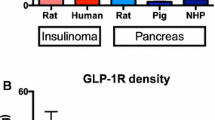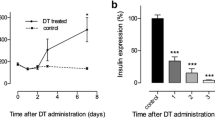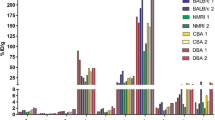Abstract
Purpose
The purpose of this study was to evaluate the binding specificity of the radiolabeled glucagon-like peptide 1 receptor (GLP-1R) agonist (Lys40(DOTA)NH2)Exendin-4 in the pancreas using a combination of ex vivo autoradiography and immunohistochemistry.
Procedures
Sprague–Dawley rats were administered [64Cu](Lys40(DOTA)NH2)Exendin-4 i.v. with or without unlabeled Exendin (9-39) to determine binding specificity. Similar experiments were performed using Zucker diabetic fatty (ZDF) and Zucker lean (ZLC) rats. Animals were euthanized and the pancreas was extracted, immediately frozen, and sectioned. The sections were apposed to phosphor imaging plates, scanned, and immunostained for insulin.
Results
Co-registration of the autoradiographic and immunohistochemical images revealed that [64Cu] (Lys40(DOTA)NH2)Exendin-4 specific binding was restricted to islet cells. This binding was blocked by the co-administration of Exendin(9-39) indicating that the radiotracer uptake is mediated by GLP-1R. Uptake of [64Cu](Lys40(DOTA)NH2)Exendin-4 was greatly decreased in the pancreas of ZDF rats.
Conclusions
Ex vivo autoradiography results using [64Cu](Lys40(DOTA)NH2)Exendin-4 suggest that GLP-1R agonists based on Exendin-4 are attractive PET ligands for the in vivo determination of β-cell mass.





Similar content being viewed by others
References
Centers for Disease Control and prevention (2008) National diabetes fact sheet: general information and health estimates on diabetes in the United States, 2007. US Department of Health and Human Services, Centers for Disease Control and Prevention, Atlanta
The National Institute of Diabetes and Digestive and Kidney Disease (2008) National Diabetes Statistics, 2007. US Department of Health and Human Services, National Institutes of health, Bethesda
Simpson NR, Souza F, Witkowski P, Maffei A, Raffo A, Herron A, Kilbourn M, Jurewicz A, Herold K, Liu E, Hardy MA, Van Heertum R, Harris PE (2006) Visualizing pancreatic β-cell mass with [11C]DTBZ. Nucl Med Biol 33:855–864
Kung M-P, Hou C, Lieberman BP, Oya S, Ponde DE, Blankemeyer E, Skovronsky D, Kilbourn MR, Kung HF (2008) In vivo imaging of β-cell mass in rats using 18F-FP-(+)-DTBZ: a potential PET ligand for studying diabetes mellitus. J Nucl Med 49(7):1171–1176
Fagerholm V, Mikkola KK, Ishizu T, Arponen E, Kauhanen S, Någren K, Solin O, Nuutila P, Haaparanta M (2010) Assessment of islet specificity of dohydrobenazine radiotracer binding in rat pancreas and human pancreas. J Nucl Med 51(9):1439–1446
Singhai T, Ding Y-S, Weinzimmer D, Normandin MD, Labaree D, Ropchan J, Nabulis N, Lin S-F, Skaddan MB, Soeller WC, Huang Y, Carson RE, Treadway JL, Cline GW (2010) Pancreatic beta cell mass PET imaging and quantification with [11C]DTBZ and [18F]FP-(+)-DTBZ in rodent models of diabetes. Mol Imaging Biol. doi:10.1007/s11307-010-0406-x
Bormans GM (2010) 11C-dihyrotetrabenazine cell imaging. J Nucl Med 51(9):1335–1336
Gotthardt M, Lalyko G, van Eerd-Vismale J, Keil B, Schurrat T, Hower M, Laverman P, Behr TM, Boermann O, Göke B, Béhé M (2006) A technique for in vivo imaging of specific GLP-1 binding sites: first results in small rodents. Reg Peptides 137(3):162–167
Mukai E, Toyoda K, Kimura H, Kawashima H, Fujimoto H, Ueda M, Temma T, Hirao K, Nagakawa K, Saji H, Inagaki N (2009) GLP-1 receptor antagonist as a potential probe for pancreatic β-cell imaging. Biochem Biophys Res Commun 389:523–526
Drucker DJ (2006) The biology of incretin hormones. Cell Metab 3:153–165
Doyle ME, Egan JM (2007) Mechanisms of action of glucagon-like peptide 1 in the pancreas. Pharm & Therap 113(3):546–593
Wang Q, Brubaker PL (2002) Glucagon-like petide-1 treatment delays the onset of diabetes in 8 week-old db/db mice. Diabetologica 45:1263–1273
Runge S, Thøgersen H, Madsen K, Lau J, Rudolph R (2008) Crystal structure of the ligand-bound glucagon-like peptide-1 receptor extracellular domain. J Biol Chem 283(17):11340–11347
Mann R, Nasr N, Hadden D, Sinfield F, Abidi F, Al-Sabah S et al (2007) Peptide binding at the GLP-1 receptor. Biochem Soc Trans 35(4):713–716
McCarthy DW, Shefer RE, Klinkowstein RE, Bass LA, Margeneau WH, Cutler CS, Anderson CJ, Welch MJ (1997) Efficient production of high specific activity 64Cu using a biomedical cyclotron. Nucl Med Biol 15(24):35–43
Clark JB, Palmer CJ, Shaw WN (1983) The diabetic zucker fatty rat. Proc Soc Exp Biol Med 173:68–75
Peterson RG, Shaw WN, Neel M-A, Little LA, Eichberg J (1990) Zucker diabetic fatty rat as a model for non-insulin-dependent diabetes mellitus. ILAR News 32(3):16–27
Abeeleh MA, Ismail ZB, Alzaben KR, Abu-Halaweh SA, Al-Essa MK, Abuabeeleh J, Alsmady MM (2009) Induction of Diabetes Mellitus in Rats Using Intraperitoneal Streptozotocin: A Comparison between 2 Strains of Rats. Eur J Sci Res 32(3):398–402
Schneider S (2008) Efforts to develop methods for in vivo evaluation of the native β-cell mass. Diab Obesity and Metab 10(4):109–118
Moore A (2009) Advances in beta cell imaging. Eur J Radiol 70(2):254–257
Murthy R, Harris P, Simpson N, Van Heertum R, Leibel R, Mann JJ, Parsey R (2008) Whole body[11C]-dihydrotetrabenazine imaging of baboons: biodistribution and human dosimetry estimates. Eur J Nucl Med Mol Imaging 35(4):790–797
Miao Z, Ren G, Liu H, Jiang L, Cheng Z (2010) Small-Animal PET Imaging of Human Epidermal Growth Factor Receptor Positive Tumor with a 64Cu Labeled Affibody Protein. Bioconjug Chem 21(5):947–954
Liu D, Overbey D, Watkinson LD, Smith CJ, Daibes-Figueroa S, Hoffman TJ, Forte LR, Volkert WA, Giblin MF (2010) Comparative evaluation of three 64Cu-labeled E. coli heat-stable enterotoxin analogues for pet imaging of colorectal cancer. Bioconjug Chem 21(7):1171–1176
Cai H, Li Z, Huang C-W, Shahinian AH, Wang H, Park R, Conti P (2010) Evaluation of copper-64 labeled AmBaSar conjugated cyclic RGD peptide for improved MicroPET imaging of integrin αvβ3 expression. Bioconjug Chem 21(8):1417–1424
Orskov C, Poulsen SS (1991) Glucagonlike peptide-1- (7-36)-amide receptors only in islets of Langerhans. Autoradiographic survey of extracerebral tissues in rats. Diabetes 40:1292–1296
Heller RS, Aponte GW (1995) Intra-islet regulation of hormone secretion by glucagon-like peptide-1-(7-36) amide. Am J Physiol 269:G852–860
Heller RS, Kieffer TJ, Habener JF (1997) Insulinotropic glucagon-like petide 1 expression in glucagon-producing alpha-cells of the rat endocrine pancreas. Diabetes 46:785–791
Bullock BP, Heller RS, Habener JF (1996) Tissue distribution of messenger ribonucleic acid encoding the rat glucagon-like peptide-1 receptor. Endocrinology 137:2968–2978
Moens K, Heimberg H, Flamez D, Huypens P, Quartier E, Ling Z, Pipeleers D, Gremlich S, Thorens B, Schuit F (1996) Expression and functional activity of glucagon, glucagon-like peptide I, and glucose dependent insulinotropic peptide receptors in rat pancreatic islet cells. Diabetes 45:257–261
Tornehave D, Kristensen P, Rømer J, Bjerre Knudsen L, Heller RS (2008) Expression of the GLP-1 receptor in mouse, rat and human pancreas. J Histo Cyto 56(9):841–851
Franklin I, Gromada J, Gjinovci A, Theander S, Wollheim C (2005) β-cell secretory products activate α-cell ATP-dependent potassium channels to inhibit glucagon release. Diabetes 54:1808–1815
Acknowledgment
The authors would like to thank Lan Zhu for the determination of human GLP-1 receptor potency for (Lys40(DOTA)NH2)Exendin-4 and Karen Schlingmann for the excellent technical assistance.
Conflicts of Interest Statement/Disclosures
Brett Connolly, Amy Vanko, Paul McQuade, Xiangjun Meng, Daniel Rubins, Richard Hargreaves, Cyrille Sur, and Eric Hostetler are employees and shareholders of Merck and Co., Inc.
Author information
Authors and Affiliations
Corresponding author
Rights and permissions
About this article
Cite this article
Connolly, B.M., Vanko, A., McQuade, P. et al. Ex Vivo Imaging of Pancreatic Beta Cells using a Radiolabeled GLP-1 Receptor Agonist. Mol Imaging Biol 14, 79–87 (2012). https://doi.org/10.1007/s11307-011-0481-7
Published:
Issue Date:
DOI: https://doi.org/10.1007/s11307-011-0481-7




